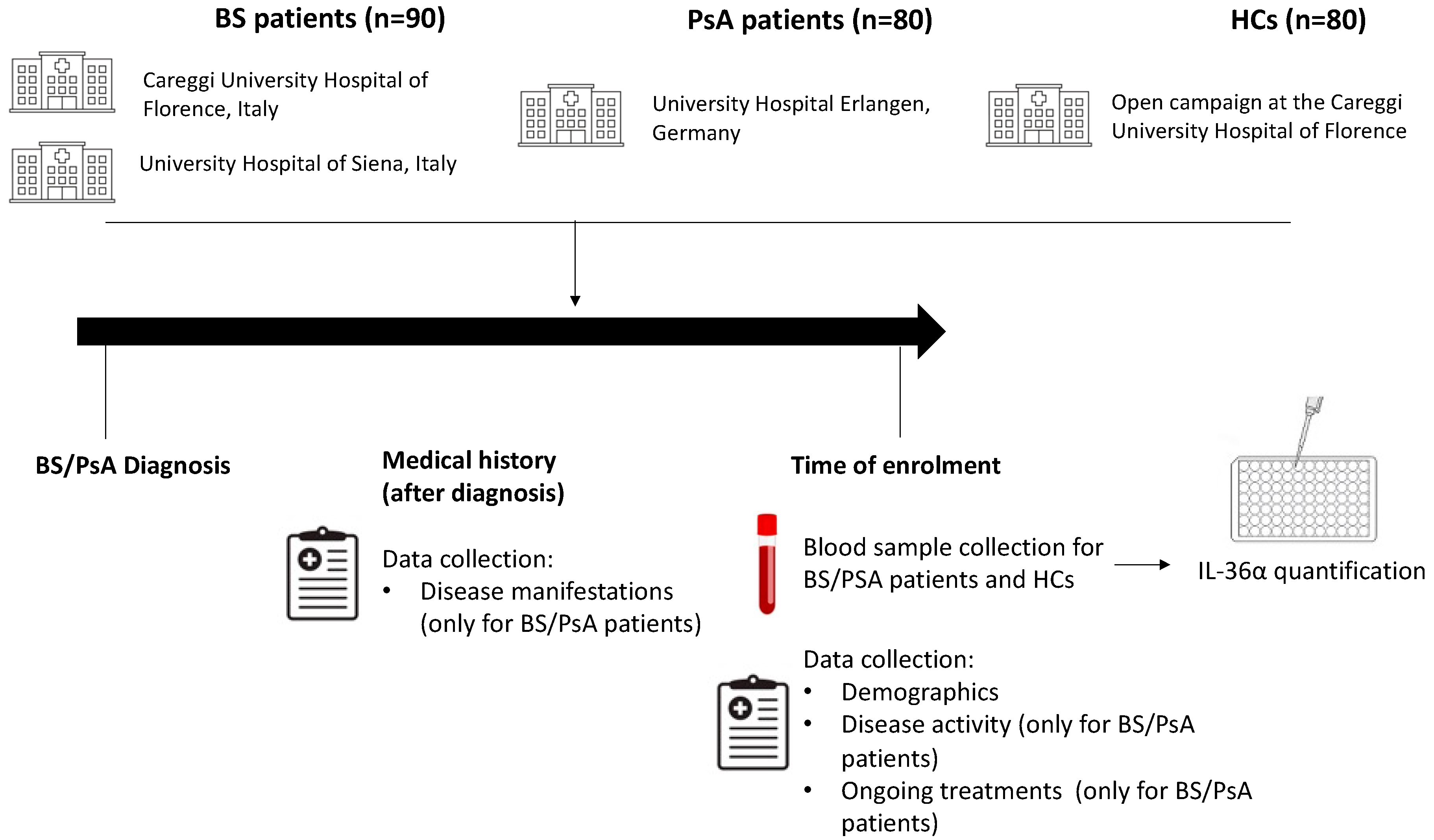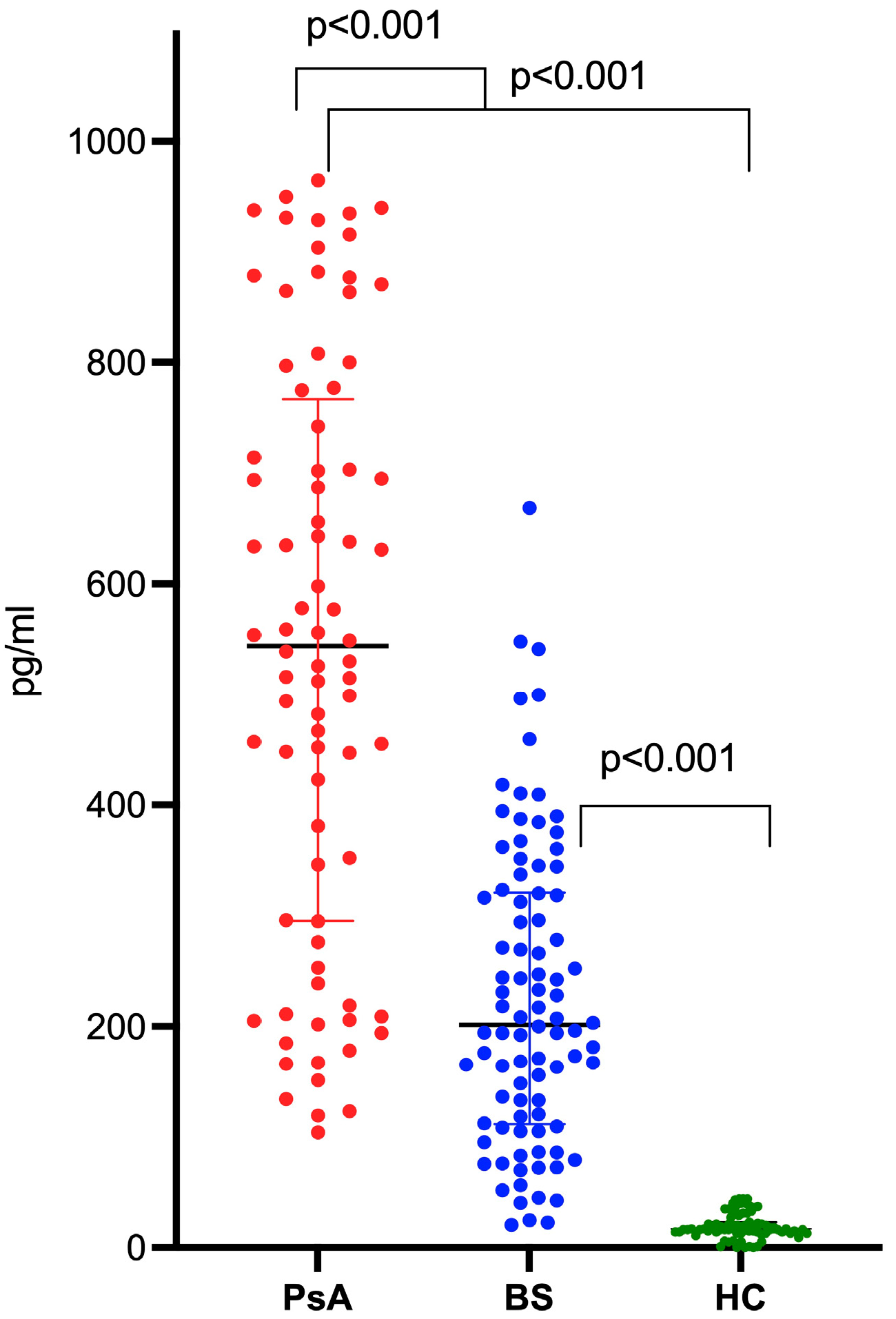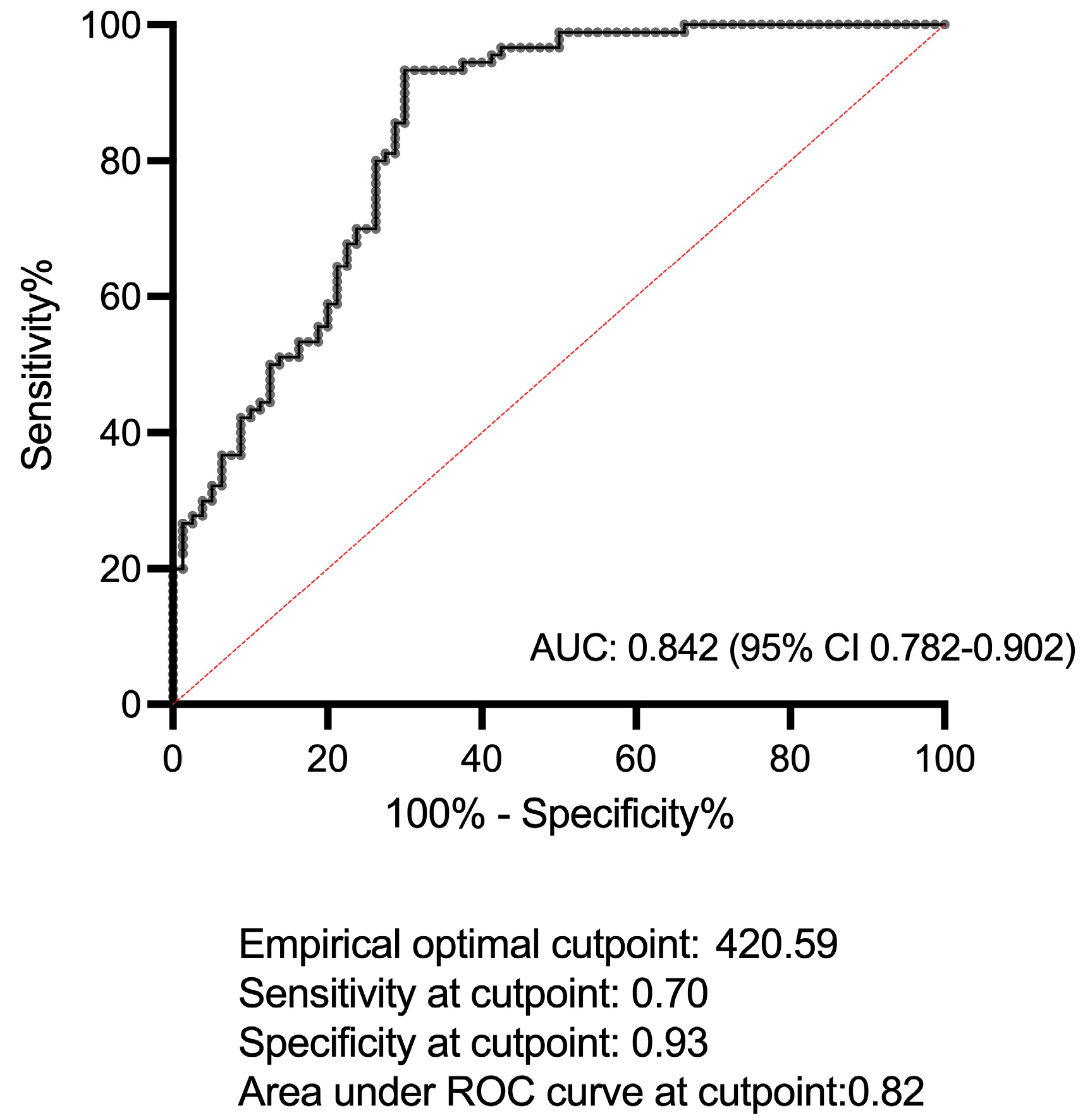Serum Interleukin-36 α as a Candidate Biomarker to Distinguish Behçet’s Syndrome and Psoriatic Arthritis
Abstract
1. Introduction
2. Results
2.1. Patients Characteristics
2.2. IL-36α Levels in Patients with BS, PsA, and in HCs
2.3. Variations in IL-36α Levels among BS Patients
3. Discussion
4. Materials and Methods
4.1. Study Design and Population
4.2. Data and Sample Collection
4.3. IL-36α Quantification
4.4. Statistical Analysis
5. Conclusions
Author Contributions
Funding
Institutional Review Board Statement
Informed Consent Statement
Data Availability Statement
Acknowledgments
Conflicts of Interest
Appendix A
| ID, Sex | Age | Disease Manifestations | HLAB51 | Active Disease | Ongoing Therapy | IL-36α Levels (pg/mL) |
|---|---|---|---|---|---|---|
| 1, M | 36 | OA, cutaneous, articular, anterior uveitis, gastrointestinal | Positive | Yes | csDMARDs | 278.3 |
| 2, F | 49 | OA, cutaneous, articular, anterior uveitis | Positive | No | csDMARDs | 233.2 |
| 3, F | 42 | OA, cutaneous, articular, gastrointestinal, positive pathergy test | Positive | No | Corticosteroids | 155.9 |
| 4, M | 56 | OA, cutaneous, articular, anterior uveitis | Positive | No | bDMARDs | 164.1 |
| 5, F | 33 | OA, cutaneous, articular, gastrointestinal, positive pathergy test | Positive | No | Corticosteroids | 360.4 |
| 6, M | 64 | OA, cutaneous, articular, anterior uveitis, gastrointestinal | Positive | Yes | csDMARDs | 387.5 |
| 7, F | 38 | OA, cutaneous, articular, positive pathergy test | Negative | Yes | csDMARDs | 186.7 |
| 8, F | 59 | OA, cutaneous, articular, anterior uveitis | Negative | No | Corticosteroids | 203.2 |

References
- Bettiol, A.; Hatemi, G.; Vannozzi, L.; Barilaro, A.; Prisco, D.; Emmi, G. Treating the Different Phenotypes of Behcet’s Syndrome. Front. Immunol. 2019, 10, 2830. [Google Scholar] [CrossRef] [PubMed]
- Bettiol, A.; Prisco, D.; Emmi, G. Behcet: The syndrome. Rheumatology 2020, 59, iii101–iii107. [Google Scholar] [CrossRef]
- Bettiol, A.; Alibaz-Oner, F.; Direskeneli, H.; Hatemi, G.; Saadoun, D.; Seyahi, E.; Prisco, D.; Emmi, G. Vascular Behcet syndrome: From pathogenesis to treatment. Nat. Rev. Rheumatol. 2023, 19, 111–126. [Google Scholar] [CrossRef] [PubMed]
- Kiafar, M.; Faezi, S.T.; Kasaeian, A.; Baghdadi, A.; Kakaei, S.; Mousavi, S.A.; Nejadhosseinian, M.; Shahram, F.; Ghodsi, S.Z.; Shams, H.; et al. Diagnosis of Behcet’s disease: Clinical characteristics, diagnostic criteria, and differential diagnoses. BMC Rheumatol. 2021, 5, 2. [Google Scholar] [CrossRef] [PubMed]
- Tursen, U.; Gurler, A.; Boyvat, A. Evaluation of clinical findings according to sex in 2313 Turkish patients with Behcet’s disease. Int. J. Dermatol. 2003, 42, 346–351. [Google Scholar] [CrossRef] [PubMed]
- Hatemi, G.; Christensen, R.; Bang, D.; Bodaghi, B.; Celik, A.F.; Fortune, F.; Gaudric, J.; Gul, A.; Kotter, I.; Leccese, P.; et al. 2018 update of the EULAR recommendations for the management of Behcet’s syndrome. Ann. Rheum. Dis. 2018, 77, 808–818. [Google Scholar] [CrossRef]
- Seyahi, E. Phenotypes in Behcet’s syndrome. Intern. Emerg. Med. 2019, 14, 677–689. [Google Scholar] [CrossRef]
- International Team for the Revision of the International Criteria for Behcet’s, D. The International Criteria for Behcet’s Disease (ICBD): A collaborative study of 27 countries on the sensitivity and specificity of the new criteria. J. Eur. Acad. Dermatol. Venereol. 2014, 28, 338–347. [Google Scholar] [CrossRef]
- Di Scala, G.; Bettiol, A.; Cojan, R.D.; Finocchi, M.; Silvestri, E.; Emmi, G. Efficacy of the anti-IL 17 secukinumab in refractory Behcet’s syndrome: A preliminary study. J. Autoimmun. 2019, 97, 108–113. [Google Scholar] [CrossRef]
- Fagni, F.; Bettiol, A.; Talarico, R.; Lopalco, G.; Silvestri, E.; Urban, M.L.; Russo, P.A.J.; Di Scala, G.; Emmi, G.; Prisco, D. Long-term effectiveness and safety of secukinumab for treatment of refractory mucosal and articular Behcet’s phenotype: A multicentre study. Ann. Rheum. Dis. 2020, 79, 1098–1104. [Google Scholar] [CrossRef]
- Olivieri, I.; Padula, A.; D’Angelo, S.; Cutro, M.S. Psoriatic arthritis sine psoriasis. J. Rheumatol. Suppl. 2009, 83, 28–29. [Google Scholar] [CrossRef] [PubMed]
- Peluso, R.; Iervolino, S.; Vitiello, M.; Bruner, V.; Lupoli, G.; Di Minno, M.N. Extra-articular manifestations in psoriatic arthritis patients. Clin. Rheumatol. 2015, 34, 745–753. [Google Scholar] [CrossRef] [PubMed]
- Hahn, H.J.; Kwak, S.G.; Kim, D.K.; Kim, J.Y. Association of Behcet disease with psoriasis and psoriatic arthritis. Sci. Rep. 2021, 11, 2531. [Google Scholar] [CrossRef] [PubMed]
- Taylor, W.; Gladman, D.; Helliwell, P.; Marchesoni, A.; Mease, P.; Mielants, H.; Group, C.S. Classification criteria for psoriatic arthritis: Development of new criteria from a large international study. Arthritis Rheum. 2006, 54, 2665–2673. [Google Scholar] [CrossRef] [PubMed]
- Novelli, L.; Lubrano, E.; Venerito, V.; Perrotta, F.M.; Marando, F.; Curradi, G.; Iannone, F. Extra-Articular Manifestations and Comorbidities in Psoriatic Disease: A Journey Into the Immunologic Crosstalk. Front. Med. 2021, 8, 737079. [Google Scholar] [CrossRef] [PubMed]
- van der Houwen, T.B.; van Hagen, P.M.; van Laar, J.A.M. Immunopathogenesis of Behcet’s disease and treatment modalities. Semin. Arthritis Rheum. 2022, 52, 151956. [Google Scholar] [CrossRef]
- Gossec, L.; Baraliakos, X.; Kerschbaumer, A.; de Wit, M.; McInnes, I.; Dougados, M.; Primdahl, J.; McGonagle, D.G.; Aletaha, D.; Balanescu, A.; et al. EULAR recommendations for the management of psoriatic arthritis with pharmacological therapies: 2019 update. Ann. Rheum. Dis. 2020, 79, 700–712. [Google Scholar] [CrossRef]
- Hu, C.J.; Pan, J.B.; Song, G.; Wen, X.T.; Wu, Z.Y.; Chen, S.; Mo, W.X.; Zhang, F.C.; Qian, J.; Zhu, H.; et al. Identification of Novel Biomarkers for Behcet Disease Diagnosis Using Human Proteome Microarray Approach. Mol. Cell. Proteom. 2017, 16, 147–156. [Google Scholar] [CrossRef]
- Cavalli, G.; Colafrancesco, S.; Emmi, G.; Imazio, M.; Lopalco, G.; Maggio, M.C.; Sota, J.; Dinarello, C.A. Interleukin 1alpha: A comprehensive review on the role of IL-1alpha in the pathogenesis and treatment of autoimmune and inflammatory diseases. Autoimmun. Rev. 2021, 20, 102763. [Google Scholar] [CrossRef]
- Magne, D.; Palmer, G.; Barton, J.L.; Mezin, F.; Talabot-Ayer, D.; Bas, S.; Duffy, T.; Noger, M.; Guerne, P.A.; Nicklin, M.J.; et al. The new IL-1 family member IL-1F8 stimulates production of inflammatory mediators by synovial fibroblasts and articular chondrocytes. Arthritis Res. Ther. 2006, 8, R80. [Google Scholar] [CrossRef]
- Boutet, M.A.; Bart, G.; Penhoat, M.; Amiaud, J.; Brulin, B.; Charrier, C.; Morel, F.; Lecron, J.C.; Rolli-Derkinderen, M.; Bourreille, A.; et al. Distinct expression of interleukin (IL)-36alpha, beta and gamma, their antagonist IL-36Ra and IL-38 in psoriasis, rheumatoid arthritis and Crohn’s disease. Clin. Exp. Immunol. 2016, 184, 159–173. [Google Scholar] [CrossRef]
- Zhou, Z.Y.; Chen, S.L.; Shen, N.; Lu, Y. Cytokines and Behcet’s disease. Autoimmun. Rev. 2012, 11, 699–704. [Google Scholar] [CrossRef]
- Emmi, G.; Talarico, R.; Lopalco, G.; Cimaz, R.; Cantini, F.; Viapiana, O.; Olivieri, I.; Goldoni, M.; Vitale, A.; Silvestri, E.; et al. Efficacy and safety profile of anti-interleukin-1 treatment in Behcet’s disease: A multicenter retrospective study. Clin. Rheumatol. 2016, 35, 1281–1286. [Google Scholar] [CrossRef]
- Fabiani, C.; Vitale, A.; Emmi, G.; Lopalco, G.; Vannozzi, L.; Guerriero, S.; Gentileschi, S.; Bacherini, D.; Franceschini, R.; Frediani, B.; et al. Interleukin (IL)-1 inhibition with anakinra and canakinumab in Behcet’s disease-related uveitis: A multicenter retrospective observational study. Clin. Rheumatol. 2017, 36, 191–197. [Google Scholar] [CrossRef]
- Fabiani, C.; Vitale, A.; Rigante, D.; Emmi, G.; Lopalco, G.; Di Scala, G.; Sota, J.; Orlando, I.; Franceschini, R.; Frediani, B.; et al. The Presence of Uveitis Is Associated with a Sustained Response to the Interleukin (IL)-1 Inhibitors Anakinra and Canakinumab in Behcet’s Disease. Ocul. Immunol. Inflamm. 2020, 28, 298–304. [Google Scholar] [CrossRef]
- Bettiol, A.; Silvestri, E.; Di Scala, G.; Amedei, A.; Becatti, M.; Fiorillo, C.; Lopalco, G.; Salvarani, C.; Cantarini, L.; Soriano, A.; et al. The right place of interleukin-1 inhibitors in the treatment of Behcet’s syndrome: A systematic review. Rheumatol. Int. 2019, 39, 971–990. [Google Scholar] [CrossRef]
- Milora, K.A.; Fu, H.; Dubaz, O.; Jensen, L.E. Unprocessed Interleukin-36alpha Regulates Psoriasis-Like Skin Inflammation in Cooperation With Interleukin-1. J. Investig. Dermatol. 2015, 135, 2992–3000. [Google Scholar] [CrossRef]
- Alvarez, P.; Jensen, L.E. Imiquimod Treatment Causes Systemic Disease in Mice Resembling Generalized Pustular Psoriasis in an IL-1 and IL-36 Dependent Manner. Mediators Inflamm. 2016, 2016, 6756138. [Google Scholar] [CrossRef]
- Sehat, M.; Talaei, R.; Dadgostar, E.; Nikoueinejad, H.; Akbari, H. Evaluating Serum Levels of IL-33, IL-36, IL-37 and Gene Expression of IL-37 in Patients with Psoriasis Vulgaris. Iran. J. Allergy Asthma Immunol. 2018, 17, 179–187. [Google Scholar]
- Boutet, M.A.; Nerviani, A.; Lliso-Ribera, G.; Lucchesi, D.; Prediletto, E.; Ghirardi, G.M.; Goldmann, K.; Lewis, M.; Pitzalis, C. Interleukin-36 family dysregulation drives joint inflammation and therapy response in psoriatic arthritis. Rheumatology 2020, 59, 828–838. [Google Scholar] [CrossRef]
- Boutet, M.A.; Nerviani, A.; Pitzalis, C. IL-36, IL-37, and IL-38 Cytokines in Skin and Joint Inflammation: A Comprehensive Review of Their Therapeutic Potential. Int. J. Mol. Sci. 2019, 20, 1257. [Google Scholar] [CrossRef]
- Towne, J.E.; Renshaw, B.R.; Douangpanya, J.; Lipsky, B.P.; Shen, M.; Gabel, C.A.; Sims, J.E. Interleukin-36 (IL-36) ligands require processing for full agonist (IL-36alpha, IL-36beta, and IL-36gamma) or antagonist (IL-36Ra) activity. J. Biol. Chem. 2011, 286, 42594–42602. [Google Scholar] [CrossRef]
- Macleod, T.; Doble, R.; McGonagle, D.; Wasson, C.W.; Alase, A.; Stacey, M.; Wittmann, M. Neutrophil Elastase-mediated proteolysis activates the anti-inflammatory cytokine IL-36 Receptor antagonist. Sci. Rep. 2016, 6, 24880. [Google Scholar] [CrossRef]
- Bettiol, A.; Becatti, M.; Silvestri, E.; Argento, F.R.; Fini, E.; Mannucci, A.; Galora, S.; Mattioli, I.; Urban, M.L.; Malandrino, D.; et al. Neutrophil-mediated mechanisms of damage and in-vitro protective effect of colchicine in non-vascular Behcet’s syndrome. Clin. Exp. Immunol. 2021, 206, 410–421. [Google Scholar] [CrossRef]
- Li, B.; Li, G.; Yang, X.; Song, Z.; Wang, Y.; Zhang, Z. NETosis in Psoriatic Arthritis: Serum MPO-DNA Complex Level Correlates With Its Disease Activity. Front. Immunol. 2022, 13, 911347. [Google Scholar] [CrossRef]
- Becatti, M.; Emmi, G.; Silvestri, E.; Bruschi, G.; Ciucciarelli, L.; Squatrito, D.; Vaglio, A.; Taddei, N.; Abbate, R.; Emmi, L.; et al. Neutrophil Activation Promotes Fibrinogen Oxidation and Thrombus Formation in Behcet Disease. Circulation 2016, 133, 302–311. [Google Scholar] [CrossRef]
- Becatti, M.; Emmi, G.; Bettiol, A.; Silvestri, E.; Di Scala, G.; Taddei, N.; Prisco, D.; Fiorillo, C. Behcet’s syndrome as a tool to dissect the mechanisms of thrombo-inflammation: Clinical and pathogenetic aspects. Clin. Exp. Immunol. 2019, 195, 322–333. [Google Scholar] [CrossRef]
- Emmi, G.; Silvestri, E.; Cameli, A.M.; Bacherini, D.; Vannozzi, L.; Squatrito, D.; Emmi, L. Anakinra for resistant Behcet uveitis: Why not? Clin. Exp. Rheumatol. 2013, 31, 152–153. [Google Scholar]
- Todorovic, V.; Su, Z.; Putman, C.B.; Kakavas, S.J.; Salte, K.M.; McDonald, H.A.; Wetter, J.B.; Paulsboe, S.E.; Sun, Q.; Gerstein, C.E.; et al. Small Molecule IL-36gamma Antagonist as a Novel Therapeutic Approach for Plaque Psoriasis. Sci. Rep. 2019, 9, 9089. [Google Scholar] [CrossRef]
- Wolf, J.; Ferris, L.K. Anti-IL-36R antibodies, potentially useful for the treatment of psoriasis: A patent evaluation of WO2013074569. Expert. Opin. Ther. Pat. 2014, 24, 477–479. [Google Scholar] [CrossRef]
- Scheibe, K.; Backert, I.; Wirtz, S.; Hueber, A.; Schett, G.; Vieth, M.; Probst, H.C.; Bopp, T.; Neurath, M.F.; Neufert, C. IL-36R signalling activates intestinal epithelial cells and fibroblasts and promotes mucosal healing in vivo. Gut 2017, 66, 823–838. [Google Scholar] [CrossRef]
- Medina-Contreras, O.; Harusato, A.; Nishio, H.; Flannigan, K.L.; Ngo, V.; Leoni, G.; Neumann, P.A.; Geem, D.; Lili, L.N.; Ramadas, R.A.; et al. Cutting Edge: IL-36 Receptor Promotes Resolution of Intestinal Damage. J. Immunol. 2016, 196, 34–38. [Google Scholar] [CrossRef]
- Frey, S.; Derer, A.; Messbacher, M.; Baeten, D.L.P.; Bugatti, S.; Montecucco, C.; Georg Schett, G.; Hueber, A.J. The novel cytokine interleukin-36α is expressed in psoriatic and rheumatoid arthritis synovium. Ann. Rheum. Dis. 2013, 72, 156974. [Google Scholar] [CrossRef]
- Smith, D.E.; Renshaw, B.R.; Ketchem, R.R.; Kubin, M.; Garka, K.E.; Sims, J.E. Four new members expand the interleukin-1 superfamily. J. Biol. Chem. 2000, 275, 1169–1175. [Google Scholar] [CrossRef]
- Queen, D.; Ediriweera, C.; Liu, L. Function and Regulation of IL-36 Signaling in Inflammatory Diseases and Cancer Development. Front. Cell. Dev. Biol. 2019, 7, 317. [Google Scholar] [CrossRef]
- Wang, Q.; Yi, S.; Su, G.; Du, Z.; Pa, S.; Huang, X.; Cao, Q.; Yuan, G.; Kijlstra, A.; Yang, P. Changes in the Gut Microbiome Contribute to the Development of Behcet’s Disease via Adjuvant Effects. Front. Cell Dev. Biol. 2021, 9, 716760. [Google Scholar] [CrossRef]
- Liu, Y.; Fan, Q.Y.; Zhang, N.; Mi, L.Y.; Zhao, X.; Xu, K. Characterisation of circulating endothelial microparticles in Behçet’s disease: New markers of chronic endothelial damage? Clin. Exp. Rheumatol. 2023. [Google Scholar] [CrossRef]


| BS N (% Out of 90) | PsA N (% Out of 80) | Healthy Controls N (% Out of 80) | |
|---|---|---|---|
| Sex—male | 51 (56.7) | 42 (52.5) | 42 (52.5) |
| Age, years (median, IQR) | 45 (36–55) | 50 (38–66) | 45 (38–52) |
| Disease manifestations | |||
| Oral aphthosis | 84 (93.3) | 2 (2.5) | |
| Genital aphthosis | 34 (37.8) | 0 (0) | |
| Cutaneous | 73 (81.1) | - | |
| Psoriasis | - | 72 (90.0) | |
| Arthritis | 47 (52.2) | 80 (100.0%) | |
| Gastrointestinal symptoms | 34 (38.2) | 9 (11.3%) | |
| Uveitis | 31 (34.4) | 5 (6.3%) | |
| Vascular | 17 (18.9) | 7 (8.8%) * | |
| Neurological | 16 (17.8) | - | |
| HLA-B51 positivity | 40 (44.4) | - | |
| Active disease | 44 (48.9) | 37 (46.3) | |
| BDCAF (median, IQR) | 0 (0–3) | - | |
| PASI (median, IQR) | - | 1.2 (0–2.1) | |
| Ongoing immunomodulating treatment | |||
| No treatment/only NSAIDs | 0 | 10 (12.5) | |
| Corticosteroids/colchicine | 36 (40.0) | 3 (3.8) | |
| csDMARDs | 29 (32.2) | 30 (38.5) | |
| Methotrexate | 0 | 28 (35.0) | |
| Leflunomide | 0 | 2 (3.5) | |
| Biologic (±cs) DMARDs | 25 (27.8) | 37 (46.3) | |
| TNFi | 21 (23.3) | 27 (33.8) | |
| IL12/23i | 0 | 3 (3.8) | |
| IL1i | 4 (4.4) |
| With the Considered Feature | Without the Considered Feature | p-Value # | |
|---|---|---|---|
| IL-36 (pg/mL) | IL-36 (pg/mL) | ||
| Overall | 201.7 (112.7–320.2) | ||
| Disease manifestations | |||
| Genital aphthosis | 269.4 (173.2–384.5) | 176.1 (109.2–266.3) | 0.015 * |
| Cutaneous | 207.2 (132.9–323.4) | 192.2 (94.9–271.2) | 0.284 |
| Arthritis | 201.7 (120.2–320.2) | 194.2 (104.8–344.2) | 0.784 |
| Intestinal symptoms | 212.2 (104.8–360.4) | 200.2 (118.2–316.5) | 0.950 |
| Uveitis | 243.4 (192.2–345.1) | 173.2 (94.9–312.3) | 0.029 * |
| Vascular | 269.4 (208.2–351.4) | 192.2 (108.1–296.2) | 0.072 |
| Neurological | 228.3 (171.1–375.2) | 194.3 (108.1–318.3) | 0.240 |
| HLA-B51 | 229.7 (152.0–340.8) | 193.2 (94.9–312.3) | 0.237 |
| Active disease | 200.7 (106.5–379.9) | 201.7 (133.0–296.2) | 0.529 |
| BDCAF | Spearman’s rho: 0.492 | <0.001 * | |
| Ongoing immunomodulating treatment | |||
| Corticosteroids/colchicine | 245.7 (160.5–348.3) | 0.138 | |
| csDMARDs | 192.2 (120.2–252.2) | ||
| Biologic (±cs) DMARDs | 176.1 (82.9–294.4) | ||
Disclaimer/Publisher’s Note: The statements, opinions and data contained in all publications are solely those of the individual author(s) and contributor(s) and not of MDPI and/or the editor(s). MDPI and/or the editor(s) disclaim responsibility for any injury to people or property resulting from any ideas, methods, instructions or products referred to in the content. |
© 2023 by the authors. Licensee MDPI, Basel, Switzerland. This article is an open access article distributed under the terms and conditions of the Creative Commons Attribution (CC BY) license (https://creativecommons.org/licenses/by/4.0/).
Share and Cite
Bettiol, A.; Fagni, F.; Mattioli, I.; Bagni, G.; Vitiello, G.; Grassi, A.; Della Bella, C.; Benagiano, M.; Troilo, A.; Holownia, K.S.; et al. Serum Interleukin-36 α as a Candidate Biomarker to Distinguish Behçet’s Syndrome and Psoriatic Arthritis. Int. J. Mol. Sci. 2023, 24, 8817. https://doi.org/10.3390/ijms24108817
Bettiol A, Fagni F, Mattioli I, Bagni G, Vitiello G, Grassi A, Della Bella C, Benagiano M, Troilo A, Holownia KS, et al. Serum Interleukin-36 α as a Candidate Biomarker to Distinguish Behçet’s Syndrome and Psoriatic Arthritis. International Journal of Molecular Sciences. 2023; 24(10):8817. https://doi.org/10.3390/ijms24108817
Chicago/Turabian StyleBettiol, Alessandra, Filippo Fagni, Irene Mattioli, Giacomo Bagni, Gianfranco Vitiello, Alessia Grassi, Chiara Della Bella, Marisa Benagiano, Arianna Troilo, Katarzyna Stella Holownia, and et al. 2023. "Serum Interleukin-36 α as a Candidate Biomarker to Distinguish Behçet’s Syndrome and Psoriatic Arthritis" International Journal of Molecular Sciences 24, no. 10: 8817. https://doi.org/10.3390/ijms24108817
APA StyleBettiol, A., Fagni, F., Mattioli, I., Bagni, G., Vitiello, G., Grassi, A., Della Bella, C., Benagiano, M., Troilo, A., Holownia, K. S., Simon, D., Argento, F. R., Sota, J., Fabiani, C., Becatti, M., Fiorillo, C., Schett, G., Lopalco, G., Cantarini, L., ... D’Elios, M. M. (2023). Serum Interleukin-36 α as a Candidate Biomarker to Distinguish Behçet’s Syndrome and Psoriatic Arthritis. International Journal of Molecular Sciences, 24(10), 8817. https://doi.org/10.3390/ijms24108817








